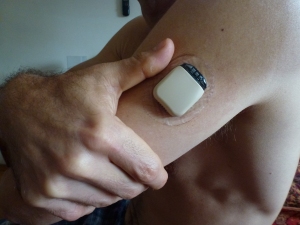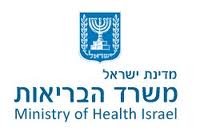Abbot Diabetes Care FreeStyle Navigator II Continuous Glucose Monitoring System Product Review
The overdue successor to Abbott’s first generation FreeStyle CGM, the Abbott Diabetes Care FreeStyle Navigator II delivers on all fronts: accurate sensor, smaller transmitter, longer range and flexible reports. Now if only they’d improve the sensor adhesive…
Me & My FreeStyle Navigator 2.0
To the dismay of many satisfied users in the U.S., the original FreeStyle Navigator (Nav) was permanently discontinued by Abbott Diabetes Care (ADC) in 2011 following an unexplained “supply interruption.” Since then, ADC continued to supply this device – and an upgraded 1.5 version – throughout Europe and the Middle East.
In April 2013, ADC performed a soft launch of the redesigned FreeStyle Navigator II (Nav2), introducing it on a limited basis to customers in the UK, Germany, Scandinavia, Holland & Israel. I was fortunate to be one of the first to give it a go.
Receiver Display
Let me be perfectly blunt: the Nav2 receiver display is nothing like a modern-day smartphone with an HD screen. Rather it’s more like a Blackberry of yesteryear with an 8-bit color display that you will be hard-pressed to read in anything more than moderate sunlight. For retro Blackberry fans there’s a scroll wheel and two softkeys.
FreeStyle Navigator 2.0 Homescreen
The display homescreen shows the current BG reading, BG trend arrow and four-hour graph.
- Current Glucose Level
Current BG is prominently displayed on the home screen and is updated once every minute. Depending on whether the measurement is in or out of the customizable target range (mine is 80-180 mg/dL), the result appears as follows:
215 = above range (Purple)
125 = within range (Green)
65 = below range (Yellow)
- Trend Arrow
→ BG steady
↗ BG rising moderately (60-120 mg/dL per hour)
↑ BG rising rapidly (more than 120 mg/dL per hour)
↘ BG falling moderately (60-120 mg/dL per hour)
↓ BG falling rapidly (more than 120 mg/dL per hour)
Abbott markets this as TRU™ Directional Arrows that are updated with each CGM reading every minute. The idea is to tell you if glucose levels are changing gradually, moderately, or rapidly. This works reasonably well and assists in trying to master the fine art of correction bolus.
- Graph
The homescreen graph shows the last four hours of BG levels; a more detailed history is accessible via the Reports sub-menu. Glucometer tests appear with a + sign. - Sensor/Insertion
The Nav2 sensor mount and transmitter are significantly (40%) smaller than in the original Nav, with the sensor measuring glucose in the interstitial fluid 5mm under the skin. ADC authorizes use of the sensor either in the abdomen or on the back of the upper arm. I have also worn the sensor on the back of my upper and lower waist with no performance degradation.
Sensor insertion is mostly pain-free and harmless, certainly in comparison to my Medtronic infusion set inserter which is like harpooning a whale! After disconnecting the inserter, you slide the transmitter into the sensor mount until it “clicks.” Unfortunately, the ADC mechanical engineers have failed here because there isn’t really a clear/firm click and you’re left wondering if the transmitter is indeed connected properly.
Nav2 Sensor & Transmitter Affixed
My #1 problem with the sensor is the adhesive performance, or lack thereof. The first few months I was shedding sensors early and often within a couple of days. I attribute this to a double whammy: insertion only into the back of the upper arm (because of minimal fatty tissue in my stomach and a lot of core rotation in my exercise regimen) coupled with the fact that I play a lot of tennis in a hot/humid climate.
Working with the local ADC agent – Geffen Medical – we were able to resolve this using a couple of after-market products: pre-swiping the target site with a 3M Convacare barrier wipe, and post-insertion application of Smith & Nephew Opsite Flexifix transparent film strips. Notwithstanding, it would be much easier if Abbott found a stickier, water-resistant adhesive for their sensor mount.
I also had a problem with a couple of faulty sensor inserters that didn’t release the sensor into the skin. This is a known issue that ADC is working to resolve and one that didn’t occur with the previous generation FSN inserters.
Sensors are three-digit coded, and come in boxes of six for one month of usage. Although not promoted by Abbott, it is possible to detach and then re-affix the transmitter to reset/extend sensor life; however, because of my adhesion issues I was only able to do this on one occasion.
Calibration & Accuracy
You only fly blind for one hour with the Nav2. Glucose results are provided immediately after performing the first calibration so long as the calibration BG level is in the 60-400 mg/dL range.
Five calibrations – using the built-in FreeStyle (Lite) glucometer with code-free test strips – must be performed over the five-day sensor lifetime. With four calibrations in day one, you get four days with only one calibration. For me this was a major selling point: only one fingertip prick in four days. Also, BG levels are updated each and every minute, giving users the most up-to-date BG data.
Built-in FreeStyle Lite Glucometer
Occasionally, after the second calibration in particular, the system may prompt you to perform an additional test (after 15 minutes, 1 hour or 3 hours) if the BG level is unstable – rapidly rising or falling during calibration testing. A shortcut workaround for this is to perform a manual BG calibration test (or two) before the requested wait time.
| Calibration | How Long After Starting Sensor | Grace Period |
|
1 |
1 hour |
None |
|
2 |
2 hours |
30 minutes |
|
3 |
10 hours |
2 hours |
|
4 |
24 hours |
8 hours |
|
5 |
72 hours |
8 hours |
I have found the Nav2 CGM readings to be quite accurate, typically within 10% of the FreeStyle glucometer results. I have done some random testis to compare, and can say non-scientifically that I am very happy with the system’s accuracy.
One minor complaint on the built-in glucometer: while they included the bright test strip port light of the FreeStyle, it’s defaulted off, requiring an annoying button press to light up.
Connectivity & Battery Life
The Nav2 receiver is fitted with a standard mini-USB port that for PC connectivity, charging and device data download using the FreeStyle CoPilot software; a dedicated A/C wall charger is also provided. The display timeout is programmable from 15-120 seconds – to extend battery life I have set mine to the minimum 15 seconds. This is more than enough for the quick BG check, and I am now getting over seven days between charges (ADC states a battery life of three days under typical use and a full charge time of six hours).
The transmitter battery life is quoted at one year, after which the transmitter must be replaced, i.e. one-year consumable. There is a Status sub-menu that shows the receiver and transmitter status as a percentage; after five months my transmitter status is 75%.
This system uses the FreeStyle CoPilot Health Management software, and I give it a thumbs down as it’s available only for PC, not Mac. Really, it’s not a great software suite, I must say.
Events & Alarms
You can create a history of your daily activities using pre-defined events, including Insulin (type and units), Food (breakfast, lunch, dinner, snack), Exercise (aerobics, walking, jogging, running, swimming, biking, weights, other) and State of Health (Normal, Cold, Sore Throat, Infection, Tired, Stress, Fever, Flu, Allergy, Period, Dizzy, Feel Low, Feel High). You can add eight custom events; unfortunately you cannot define a custom event descriptor.
Programmable alarms include: Low Glucose, High Glucose, Projected Low, Projected High, Data Loss and System. Each alarm type includes a programmable tone and/or vibrate option as well as a snooze time. Different values can be programmed for Day and Night.
- Low Glucose Threshold – range is 60-119 mg/dL
- High Glucose Threshold – range is 120-300 mg/dL
- Projected Low – advance notification of 10/20/30 minutes when approaching the Low Glucose threshold.
- Projected High – advance notification of 10/20/30 minutes when approaching the High Glucose threshold.
- Data Loss – indicates glucose results are no longer available. Reasons for this include:
- Expired sensor (clicking the scroll wheel shows when the sensor will expire)
- Overdue calibration
- Sensor not working correctly
- Transmitter disconnected from the receiver
Unsurprisingly, I have gotten acquainted with each of these alarm types, in particular the Projected Low that has saved me from many a hypo. The Data Loss alarm caused by transmitter disconnect frequently occurs immediately after insertion of a new sensor. When first pairing the transmitter with the receiver after connecting a new sensor, I found that performing the Connect to Sensor function a couple of times seems to keep it connected going forward.
Other disconnects occurred when I was out of range in my duplex apartment with reinforced concrete. The stated range is 30m/100ft line-of-sight, similar to what I witnessed, and long enough to cover me on the tennis court.
Reports
The history and reporting are quite flexible and easy to use. For a graphical representation, from the Home screen you press the Graph softkey and then use the scroll wheel to go back as far as you want in 4-hour increments.
To dig deep into the numbers, from the Reports menu you get a complete CGM history in 10/20/120 minute increments, CGM statistics including one-day average/high/low, as well as percentage of time spent at/above/below the Target range. There are also separate detailed BG test history and Events reports.
Carry Case
The Nav2 comes with three colored skins: purple, pink and black. Although they protect the receiver from the occasional drop, they are not convenient when it comes to carrying it. I prefer to use the zippered case that Abbott provided with the original Nav: not only does it offer some protection, but it also has a belt clip for wearing on-person as opposed to in-pocket with the skin. Although not a perfectly snug fit, it does leave room for some cash and cards.
Conclusion
Despite a few quirks and idiosyncrasies, the Abbott FreeStyle Navigator II has really improved my T1D quality of life. CGM accuracy is high and the minute-by-minute BG updates are a godsend for this amateur athlete. Sensor life may be shorter than with Dexcom G4 or Medtronic Enlite, but having four days with only one fingertip test is a treat.
Pricing is different by country, and luckily I have no out-of-pocket expenses in Israel. But I have seen Abbott’s UK pricing: $1,500 for the FreeStyle Navigator 2.0 receiver and transmitter, and $600 for a month’s supply of sensors.
Abbott has always been a leader with the FreeStyle glucose measurement technology, and the Nav2 doesn’t disappoint – built-in FreeStyle glucometer, extended transmission range, flexible graphical & numerical reports, programmable alarms – the FreeStyle Navigator 2.0 has it all. My wife Meirav and I both love it, now they just need to make it stick to the skin!









Recent Comments